Achieving work-life balance in a post-COVID society

The COVID-19 pandemic altered the way everyone lived and worked. Being stuck at home for the past two years threw all previously planned work-life balance out the window.
With companies issuing orders of going back to their offices, it is now time to build a new plan to perfectly balance personal and professional time while being productive in both departments.
The following article will discuss the importance of having a good work-life balance and how it can be achieved in a post-COVID society.
What is work-life balance?
Work-life balance is the ability to pay equal attention to your professional and personal lives. This means that an individual’s work-related tasks are done on time, and they still have the energy left to enjoy after-work activities.
According to University College London (UCL) Professor Anna Cox, work-life balance is the feeling of being in control over how you divide your attention between work and family while still maintaining happiness, fulfillment, and job satisfaction.
Good work-life balance results in less stress, a lower risk of burnout, and a greater sense of well-being.
Companies that also advocate for a good work-life balance have a more loyal and productive workforce that does not go on frequent absences and vacations.

How did the pandemic change everyone’s work-life balance?
Staying at home eliminated a lot of our old work routines. Instead of waking up early to dress up and commute for a few hours every day, workers did their jobs in the comfort of their homes during the pandemic.
Aside from the work attires and commute time, the lockdowns and various restrictions in the past two years have also affected our other work habits and outlook.
Here are some of the ways the pandemic changed people’s work-life balance.
Remote work
Due to the pandemic, workers had to move out of their office cubicles and into their houses. Many of them created dedicated workspaces at home or occupied tables in co-working spaces or even coffee shops.
This flexible arrangement made people realize that most of their tasks can be taken care of even outside the four corners of office space. However, since people are working outside the supervision of their managers, they feel compelled to do their jobs well.
Among the few negative effects of remote working on work-life balance is working longer hours just to submit an excellent report to the leaders.
Flexible schedule
Working at home led employers to be more lenient with their employees’ time. A flexible work schedule gives workers the ability to control their time. This means that people can start their work earlier to finish their shifts earlier or start it later in the day.
Career switches
Staying at home for a longer period than first expected made everyone think about their career choices. It also made them evaluate whether they are still happy with their jobs or are ready to move on to new careers that they could enjoy more.

How to achieve work-life balance post-COVID?
Now that companies are starting to implement their back-to-office plans, here are some ways to build a better work-life balance for yourself.
Work on what you love
Your career should be about personal development and not restraint. It should allow you to explore the things that you love doing instead of turning you into a robot with responsibilities.
If you find yourself stuck on a job that is draining you and does not give you time to explore things outside of work, then get out. Work on something that you love — or at least something you can enjoy.
Focus on yourself and your loved ones
You should not dedicate your entire life to your job. Your physical, emotional, and mental health should always be at the top of your priorities, among everything.
Additionally, make time for your loved ones. Do not neglect your personal relationships just because of a busy schedule. The time you spend on your work should be balanced with the time you spend with your family and friends.
Unplug
It is difficult to unplug, especially in today’s hyper-connected world. Technology has made it much more challenging for us to have a work-life balance.
With a mobile device and internet on hand, your manager can reach you in a matter of seconds. And, with notifications and “marked as read” buttons, it is impossible to hide your awareness of messages.
However, unplugging from the rest of the world from time to time is critical. It serves as a time for recovery after weeks or months of stress at work. Moreover, vacations allow you to think of new ideas that you can apply to work when you return.
Set boundaries
Avoid burnout by setting boundaries between yourself and your work colleagues. Allow yourself to stay free of work-related thoughts once your shift is done.
You can use Google Chrome’s profile feature to separate your work and personal email so you can filter work comms from social media platforms.
Turn off your notifications once it is past your work time so that you can focus on other things outside of work.

Use your leave benefits
Every day is not the same — there may be easy days, and there may be rough days. Don’t be afraid to call in sick on the latter. Your leave benefits are there for you to use.
To achieve a good work-life balance, it is important to take a breather once in a while and spend your day how you want to, without thinking about your workload back in the office.







 Independent
Independent




